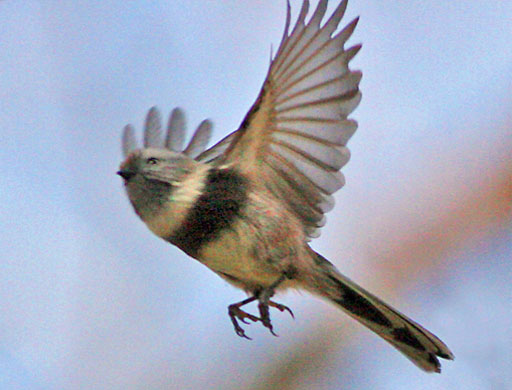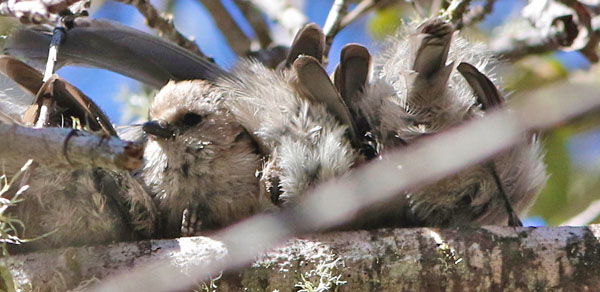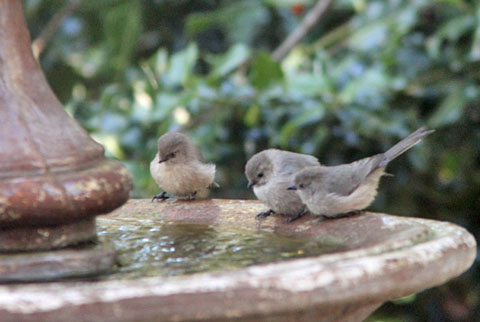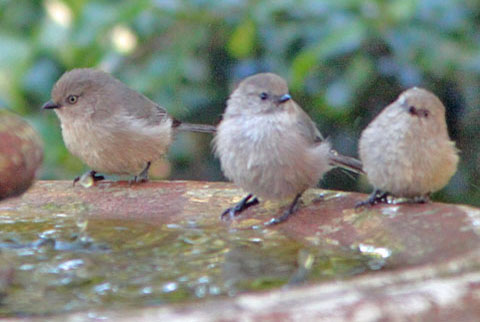| |
LONG-TAILED TITS Aegithalidae |
- 11 species worldwide
- DR personal total: 9 species (88%), 4 photo'd
|
 The Aegithalidae is a small family of tiny passerines found mostly in the Palearctic, but with a single species in western North America and another isolated in the mountains of Java. The one New World representative is Bushtit (left), whose ancestor is hypothesized to have reached North America via the Bering Strait land bridge 10–12 million years ago (Sibley & Ahlquist (1990). Bushtits roam actively through trees and bushes in family parties and small flocks, and if you have any tinge of anthropomorphism in you, you'll think they are "cute." As are all members of this family. The Aegithalidae is a small family of tiny passerines found mostly in the Palearctic, but with a single species in western North America and another isolated in the mountains of Java. The one New World representative is Bushtit (left), whose ancestor is hypothesized to have reached North America via the Bering Strait land bridge 10–12 million years ago (Sibley & Ahlquist (1990). Bushtits roam actively through trees and bushes in family parties and small flocks, and if you have any tinge of anthropomorphism in you, you'll think they are "cute." As are all members of this family.
There are 11 species in 4 genera but the heart of the family is comprised of the 7 species in genus Aegithalos. One is widespread in northern Eurasia (it is actually called "Long-tailed Tit"); most of the rest are birds of the Himalayas and related mountains east into China.
On a visit to mid-elevations in the Himalayas of Bhutan, we found pairs and little flocks of colorful Black-browed Tit (below), often in mixed species flocks. Of the various tits in this family, some are pine-and-oak forest birds (like Black-browed Tit) while others specialize on habitats dominated by juniper, birch, or oak. |
-24Mr19ThrumingLa_9681ff.jpg) |
 The European representative, whose range stretches all the way across Eurasia to China, is Long-tailed Tit (right; in a nice photo © Blake Matheson). They, like most of the species in the family, move quickly through the woods in small, noisy parties. I say "noisy" because they are very vocal, but the sound is soft an sibilant, and is likely heard only by the "tuned-in" birders. These little flocks usually move rapidly and, if you're not quick, suddenly they are gone. In woods near the Great Wall of China, we had great trouble showing them to members of our tour because of these attributes. On the other hand, they are a standard feature of suburban parks and gardens in Europe, and were among the first birds I saw in France during my teenage wander through the Bois du Bologne way back in 1969. The European representative, whose range stretches all the way across Eurasia to China, is Long-tailed Tit (right; in a nice photo © Blake Matheson). They, like most of the species in the family, move quickly through the woods in small, noisy parties. I say "noisy" because they are very vocal, but the sound is soft an sibilant, and is likely heard only by the "tuned-in" birders. These little flocks usually move rapidly and, if you're not quick, suddenly they are gone. In woods near the Great Wall of China, we had great trouble showing them to members of our tour because of these attributes. On the other hand, they are a standard feature of suburban parks and gardens in Europe, and were among the first birds I saw in France during my teenage wander through the Bois du Bologne way back in 1969.
The Aegithalidae was traditionally considered to be close relatives of the tits, titmice, and chickadees (Paridae). Although Bushtits in California often occur together with chickadees in the same general habitat, the closely knit family units of Bushtit tend to forage most often in single species groups. Molecular studies early this century place the Aegithalidae nearer to various families within the massive Sylvioidea radiation [e.g., the "break-up of the Old World Warblers"]. Long-tailed Tits are now thought to be close to leaf-warblers (Phylloscopidae) and bush-warblers & cettids (Scotocercidae; e.g., Beresford et al. 2005, Alström et al. 2006, Alström et al. 2011, Oliveros et al. 2019). |
-24Mr19ThrumingLa9688f.jpg) |
The taxonomy of long-tailed tits in Asia is complex and uncertain. Black-browed Tit (left, and also near the top of this page), currently has 4 subspecies, and three field-identifiable "groups" among those populations. This one is the nominate subspecies (iouschistos) and called the "Rufous-fronted" group, from its rufous face and broad headstripe; other populations have white faces and forehead. It occurs along the south flank of the Himalayas from central Nepal to Bhutan and into China.
Black-throated Tit (below left, photo © Ron Saldino) has a wide range from Pakistan and India well east into China, with 6 subspecies and 3 field-identifiable "groups." This one, in India, is part of the nominate "Black-throated" group. It is quite possible that both Black-browed and Black-throated Tits will be split into several species as more genetic, ecological, and vocal studies are done.
Sooty Tit (just below) is genetically related to Black-browed Tit, but is endemic to middle-elevations in mountains of central China. It likes willows and riparian scrub along streams set in forests of fir and oak. It is quite distinctive with its gray head and broad black breastband. |
 |
 |
|
In the mountains of west and central Java, the endemic Pygmy Tit Psaltria exilis is reasonably common. However, it looks and behaves very much like Bushtit in North America, except for its yellow or fleshy legs. Its sibilant calls also recall Bushtit. It feels as if the ancestor to each species was perhaps widespread but went extinct, leaving these two isolated populations, now assigned to different genera, now separated half-a-world apart.
 The sole North American representative is Bushtit, a tiny long-tailed bundle of nervous energy in western oak or riparian woodlands. Bushtits build a very impressive pendant nest (right) — an elaborate pocket hung from a hood of woven spider web from an overhanging branch. Eurasian members of the family also build impressive woven handing nests and line them with feathers (usually feathers of other species). One Long-tailed Tit nest had 2,379 feathers in its lining! The sole North American representative is Bushtit, a tiny long-tailed bundle of nervous energy in western oak or riparian woodlands. Bushtits build a very impressive pendant nest (right) — an elaborate pocket hung from a hood of woven spider web from an overhanging branch. Eurasian members of the family also build impressive woven handing nests and line them with feathers (usually feathers of other species). One Long-tailed Tit nest had 2,379 feathers in its lining!
In most species there are "helpers" at the nest (often the young from prior years) although this is not common in Bushtit. Addicott (1938) gave many details of the breeding biology of Bushtits. I rather like her description of the fledging process:
"When the nestlings are ready to fly, the slightest disturbance sends them out of the nest. As one juvenile starts to leave, the impulse spreads rapidly to the others. So quickly do they pop out of the nest that one has the feeling that the nest has suddenly exploded. There is an incessant medley of juvenile thrills. They fly awkwardly ... and scatter in all directions.... The parents ... dash from one young bird to another in an evident effort to protect them and to get them together. This is quite a task.. and the parents spend up to a half hour gathering the scattered family in low bushes or in a small tree."
Youngsters, and sometimes the entire family, huddle together for warmth or companionship (below).

|
|
Small flocks of Bushtit are readily found because they are constantly vocalizing with soft conversational call-notes. In winter in California, bushtit flocks range from about 5 to 25 birds but most often when I've counted them individually they run 12-13 individuals. Adult females are pale-eyed but adult males and youngsters are dark-eyed. It is engaging watching a flock in our birdbath (above, both photos). You can pick-out the pale-eyed female in the right-hand photo.
There are three separated populations of Bushtit in North America: the "Plain Bushtit" [minimus] of coastal and foothill oaks west of the Sierra Nevada (all photos on this page); "Lead-colored Bushtit" [plumbeus] in the Great Basin — these are much grayer and seemingly specialize on junipers; and the "Black-eared Bushtit" [melanotis] of west Texas to the mountains of Guatemala. Sibley & Monroe (1990) thought it possible that these might represent separate species. In fact, when I started birding in the early 1970s, the "Black-eared Bushtit" was split from the others as a species. The "black-eared" character proved to be relatively unimportant since young male "Lead-colored Bushtit" could also share this feature. Raitt (1967) showed a narrow zone of secondary intergradation around the U.S./Mexico in west Texas. It is still possible, though, that the coastal and interior populations might prove to be separate species. |
| |
Photos: The first photo of Bushtit Psaltriparus minimus, of the "Plain" group, was at Salinas River NWR, Monterey Co., California, on 8 Mar 2015. All photos of Black-browed Tit Aegithalos iouschistos iouschistos, of the "Rufous-fronted" group, were taken at Thrumming La, Bhutan, on 24 Mar 2019. Blake Matheson took the photo of Long-tailed Tit Aegithalos caudatus at Port Meadow, Oxfordshire, UK, on 2 Feb 2005. Ron Saldino took the photo of Black-throated Tit Aegithalos concinnus at Naini Tal, northwestern India, in February 2001. The Sooty Tit Aegithalos fuliginosus was at Foping Reserve, Shaanxi, China, on 11 Nov 2010. The Przewalski's Nuthatch Sitta przewalskii was at Huzu NP, Ganzu, China, on 14 June 2004. The Bushtit Sitta oenochlamys nest was at Laguna Grande Park, Seaside, California, on 21 Mar 2017. The packed-together fledglings were at Frog Pond Reserve, Monterey Co., California, on 15 Sep 2018, and those in the birdbath were in my Pacific Grove, California, yard on 17 Nov 2013.
Photos © Blake Matheson and © Ron Saldino, as credited; remaining photos © Don Roberson; all rights reserved.
Family book: Rating 
Harrap, Simon, and David Quinn. 1995. Chickadees, Tits, Nuthatches & Treecreepers. Princeton Univ. Press, Princeton, N. J.
This is a pleasant and solid addition to the family books in the Princeton series and it covers the Aegithalidae as well as the families named in the title. The plates appear separately in the front. I found the artwork rather good in a "field guide" style (without much background) opposite summary pages which include small maps. The maps I looked at were quite good (e.g., they and the text covered isolated populations of Mountain Chickadee in California, an unexpected bit of accuracy I've come to not expect in such family tomes). Distinct races are nicely covered and the discussion of the races of Long-tailed Tit and variation in Bushtit is quite good. The text cover identification, habitat, breeding biology (very summarized), relationships, and detailed plumage descriptions, plus references which (in contrast to other similar efforts) look reasonably extensive. I don't personally see the need for the detailed plumage descriptions since no book like this can hope to cover the complete range of variation, and they are very tedious to read, but it is the "style" of these family books. There are some helpful extra maps and sketches of plumage details scattered in the text. I was a bit put off by the use of Sibley & Monroe (1990) family taxonomy (since subject to criticism) and the unnecessary "lumping" of the penduline tits with the "true" tits. On the other hand, the authors recommend following Sibley & Monroe's (1990) species level split of Tufted and Black-crested titmice, and give a full explanation for their opinion. This sort of in-depth treatment is admirable. It is the quality of the text that prompts me to give this a "four-star" rating, just about as high of a rating that I'll give to this type of family book.
Literature cited:
Addicott, A.B. 1938. Behavior of the Bush-tit in the breeding season. Condor 40: 49-63.
Alström P., P.G.P. Ericson, U. Olsson, and P. Sundberg. 2006. Phylogeny and classification of the avian superfamily Sylvoidea. Molec. Phylog. Evol. 38: 381-397.
Alström, P., S. Fregin, J.A. Norman, P.G.P. Ericson, L. Christidis, and U. Olsson. 2011. Multilocus analysis of a taxonomically densely sampled dataset reveal extensive non-monophyly in the avian family Locustellidae. Molec. Phylog. Evol. 38: 381-397.
Beresford, P., F.K. Barker, P.G. Ryan, and T.M. Crowe. 2005. African endemics span the tree of songbirds (Passeri): molecular systematics of several evolutionary 'enigmas'. Proc. R. Soc. B 272: 849-858.
Harrop, S. 2008. Family Aegithalidae (Long-tailed Tits), pp. 76–101 in Handbook of the Birds of the World (del Hoyo, J., A. Elliott & D.A. Christie, eds). Vol. 8. Lynx Edicions, Barcelona, Spain.
Oliveros, C.H., D.J. Field, D.T. Ksepka, F.K. Barker, A. Aleixo, M.J. Andersen, P. Alström, B.W. Benz, E.L. Braun, M.J. Braun, G.A. Bravo, R.T. Brumfield, R.T. Chesser, S. Claramut, J. Cracraft, A.M. Cuervo, E.P. Derryberry, T.C. Glenn, M.G. Harvey, P.A. Hosner, L. Joseph, R.T. Kimball, A.L. Mack, C.M. Miskelly, A.T. Peterson, M.B. Robbins, F.H. Sheldon, L.F. Silveira, B.T. Smith, N.D. White, R.G. Moyle, and B.C. Faircloth. 2019. Earth history and the passerine superradiation. Proc. Nat. Acad. Sci. 116: 7916–7925.
Raitt, R.J. 1967. Relationships between Black-eared and Plain-eared forms of Bushtits (Psaltriparus). Auk 84: 503–528.
Sibley, C.G., and J.E. Ahlquist. 1990. Phylogeny and Classification of Birds: a Study of Molecular Evolution. Yale Univ. Press, New Haven, CT.
|
|
|

-24Mr19ThrumingLa_9681ff.jpg)
 The Aegithalidae is a small family of tiny passerines found mostly in the Palearctic, but with a single species in western North America and another isolated in the mountains of Java. The one New World representative is Bushtit (left), whose ancestor is hypothesized to have reached North America via the Bering Strait land bridge 10–12 million years ago (Sibley & Ahlquist (1990). Bushtits roam actively through trees and bushes in family parties and small flocks, and if you have any tinge of anthropomorphism in you, you'll think they are "cute." As are all members of this family.
The Aegithalidae is a small family of tiny passerines found mostly in the Palearctic, but with a single species in western North America and another isolated in the mountains of Java. The one New World representative is Bushtit (left), whose ancestor is hypothesized to have reached North America via the Bering Strait land bridge 10–12 million years ago (Sibley & Ahlquist (1990). Bushtits roam actively through trees and bushes in family parties and small flocks, and if you have any tinge of anthropomorphism in you, you'll think they are "cute." As are all members of this family. The European representative, whose range stretches all the way across Eurasia to China, is Long-tailed Tit (right; in a nice photo © Blake Matheson). They, like most of the species in the family, move quickly through the woods in small, noisy parties. I say "noisy" because they are very vocal, but the sound is soft an sibilant, and is likely heard only by the "tuned-in" birders. These little flocks usually move rapidly and, if you're not quick, suddenly they are gone. In woods near the Great Wall of China, we had great trouble showing them to members of our tour because of these attributes. On the other hand, they are a standard feature of suburban parks and gardens in Europe, and were among the first birds I saw in France during my teenage wander through the Bois du Bologne way back in 1969.
The European representative, whose range stretches all the way across Eurasia to China, is Long-tailed Tit (right; in a nice photo © Blake Matheson). They, like most of the species in the family, move quickly through the woods in small, noisy parties. I say "noisy" because they are very vocal, but the sound is soft an sibilant, and is likely heard only by the "tuned-in" birders. These little flocks usually move rapidly and, if you're not quick, suddenly they are gone. In woods near the Great Wall of China, we had great trouble showing them to members of our tour because of these attributes. On the other hand, they are a standard feature of suburban parks and gardens in Europe, and were among the first birds I saw in France during my teenage wander through the Bois du Bologne way back in 1969. -24Mr19ThrumingLa9688f.jpg)


 The sole North American representative is Bushtit, a tiny long-tailed bundle of nervous energy in western oak or riparian woodlands. Bushtits build a very impressive pendant nest (right) — an elaborate pocket hung from a hood of woven spider web from an overhanging branch. Eurasian members of the family also build impressive woven handing nests and line them with feathers (usually feathers of other species). One Long-tailed Tit nest had 2,379 feathers in its lining!
The sole North American representative is Bushtit, a tiny long-tailed bundle of nervous energy in western oak or riparian woodlands. Bushtits build a very impressive pendant nest (right) — an elaborate pocket hung from a hood of woven spider web from an overhanging branch. Eurasian members of the family also build impressive woven handing nests and line them with feathers (usually feathers of other species). One Long-tailed Tit nest had 2,379 feathers in its lining! 


